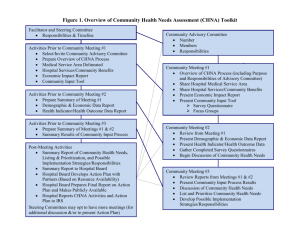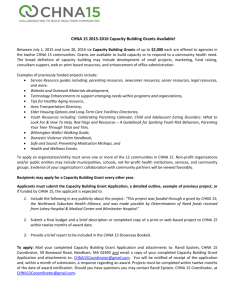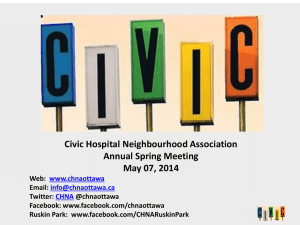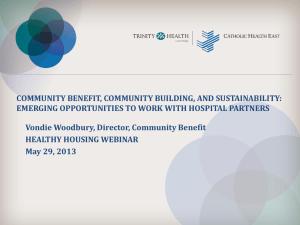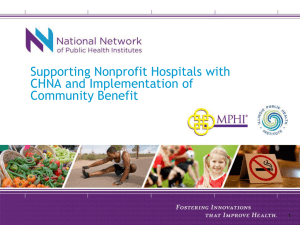APPLICATION FOR GRANTS AND SUBSIDIES (PP OBJECT CLASS)
advertisement
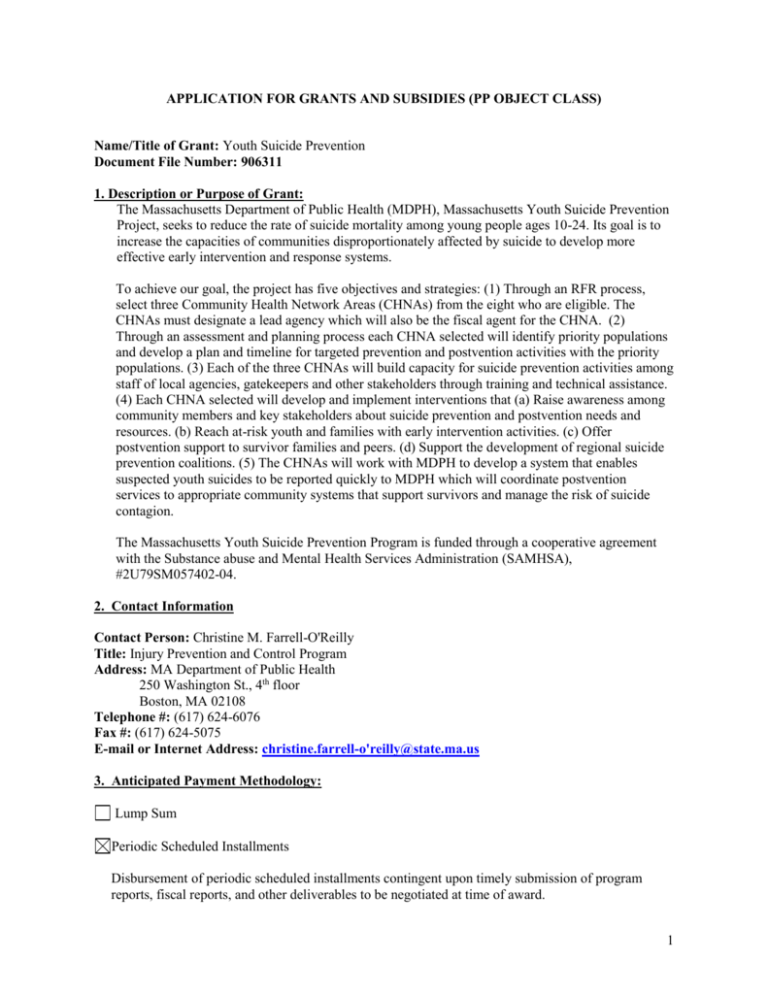
APPLICATION FOR GRANTS AND SUBSIDIES (PP OBJECT CLASS) Name/Title of Grant: Youth Suicide Prevention Document File Number: 906311 1. Description or Purpose of Grant: The Massachusetts Department of Public Health (MDPH), Massachusetts Youth Suicide Prevention Project, seeks to reduce the rate of suicide mortality among young people ages 10-24. Its goal is to increase the capacities of communities disproportionately affected by suicide to develop more effective early intervention and response systems. To achieve our goal, the project has five objectives and strategies: (1) Through an RFR process, select three Community Health Network Areas (CHNAs) from the eight who are eligible. The CHNAs must designate a lead agency which will also be the fiscal agent for the CHNA. (2) Through an assessment and planning process each CHNA selected will identify priority populations and develop a plan and timeline for targeted prevention and postvention activities with the priority populations. (3) Each of the three CHNAs will build capacity for suicide prevention activities among staff of local agencies, gatekeepers and other stakeholders through training and technical assistance. (4) Each CHNA selected will develop and implement interventions that (a) Raise awareness among community members and key stakeholders about suicide prevention and postvention needs and resources. (b) Reach at-risk youth and families with early intervention activities. (c) Offer postvention support to survivor families and peers. (d) Support the development of regional suicide prevention coalitions. (5) The CHNAs will work with MDPH to develop a system that enables suspected youth suicides to be reported quickly to MDPH which will coordinate postvention services to appropriate community systems that support survivors and manage the risk of suicide contagion. The Massachusetts Youth Suicide Prevention Program is funded through a cooperative agreement with the Substance abuse and Mental Health Services Administration (SAMHSA), #2U79SM057402-04. 2. Contact Information Contact Person: Christine M. Farrell-O'Reilly Title: Injury Prevention and Control Program Address: MA Department of Public Health 250 Washington St., 4th floor Boston, MA 02108 Telephone #: (617) 624-6076 Fax #: (617) 624-5075 E-mail or Internet Address: christine.farrell-o'reilly@state.ma.us 3. Anticipated Payment Methodology: Lump Sum Periodic Scheduled Installments Disbursement of periodic scheduled installments contingent upon timely submission of program reports, fiscal reports, and other deliverables to be negotiated at time of award. 1 Cost Reimbursement Other (specify): 4. Whether Single Or Multiple Grantees Are Required For Grant(s) Single Grantee or Multiple Grantees 5. Expected Duration Of Grant (Initial Duration and Any Options to Renew) (Subject to appropriation or the availability of sufficient non-appropriated funds under the grant funding authority) Initial Duration: up to 6 months Approximately April 1, 2009- September 30, 2009 Renewal options: 2 option to renew for approximately 12 months each. (October 1, 2009- September 30, 2011) Final End Date of this Procurement: September 30, 2011 6. Anticipated Expenditures, Funding or Compensation For Expected Duration Please include the Estimated Value of the Grant (Including Anticipated Renewal Options) Estimated total value of the grant for the thirty-one month period is approximately $900,000 which may be increased or decreased based on funding availability. Grant amounts will be approximately $80,000$110,000 per year. (Approximately $80,000 in year 1 and approximately $110,000 in year 2 and in year 3) It is estimated that a minimum of three (3) eligible CHNAs will be awarded grants. See section 7 below for eligibility criteria. Each CHNA will designate a lead agency who will also serve as the fiscal agent for the CHNA. The grants will be paid in three installments for each grant year. (Year 1 = 6 or 7 months, Years 2 & 3 = 12 months) Will Federal Funds be used to fund any part of Grant(s)? NO, YES (If YES, to what extent?): Currently fully funded by federal funds, state funds could potentially be added at a later date. Grantees receiving federal grant funds will be considered sub-recipients for federal grant purposes and will be required to comply with applicable federal requirements, including but not limited to subrecipient audit requirements under OMB Circular a-133. Capital Funds: Capital Funds must be disbursed on a cost reimbursement basis unless the amount can be received and expended by the grantee within 60 days (in order to avoid arbitrage) and the funds are held in a noninterest bearing account. Funds Balance Forward Requirement for Capital, Trust and Federal Accounts Only [Programs Designate]: This contract provides that any funds designated in the budget that are unspent in any Massachusetts state fiscal year will automatically be available for expenditure in the subsequent fiscal year. 2 7. Eligibility In Massachusetts, the risk for suicide mortality and morbidity varies significantly by region, so the project targets the eight (8) CHNAs (out of 27) with youth suicide rates or rates of non-fatal selfinflicted injury higher than those in the state and nation. Applications will be accepted from eligible Community Health Network Areas (CHNAs). Only one application may be submitted from each eligible CHNA. The CHNA will designate a lead agency that will also be the fiscal agent with the responsibility for managing the funds and providing reports to MDPH. The agency must have the fiscal and administrative capacity to manage the grant on behalf of the CHNA. The CHNA membership will need to include some or all of the following: youth-serving or family-serving agencies including schools, institutions of higher learning, hospitals and health centers, municipal government, social service agencies, first responders, police, substance abuse and mental health agencies, survivor organizations, neighborhood groups, advocacy agencies, the Centers for Healthy Communities, and faith-based organizations. The Department of Youth Services, the Department of Children and Families and the Department of Mental Health and/or agencies that have contracts to work with the populations those agencies serve, should also be included even if they have not been part of the CHNA in the past. The following eight Community Health Network Areas (CHNAs) are eligible to apply. The lead agency designated by the CHNA must be located or have a local office within and serving the populations in the following areas: CHNA 1: Community Health Network of Berkshire County, including the cities/towns of: Adams, Alford, Becket, Cheshire, Clarksburg, Dalton, Egremont, Florida, Great Barrington, Hancock, Hinsdale, Lanesborough, Lee, Lenox, Monterey, Mount Washington, New Ashford, New Marlborough, North Adams, Otis, Peru, Pittsfield, Richmond, Sandisfield, Savoy, Sheffield, Stockbridge, Tyringham, Washington, West Stockbridge, Williamstown and Windsor. CHNA 5: Southern Worcester County, including the cities/towns of: Brimfield, Brookfield, Charlton, Dudley, East Brookfield, Holland, North Brookfield, Oxford, Southbridge, Spencer, Sturbridge, Wales, Warren, Webster and West Brookfield. CHNA 9: Community Health Network of Central Massachusetts, including the cities/towns of: Ashburnham, Ashby, Ayer, Barre, Berlin, Bolton, Clinton, Fitchburg, Gardner, Groton, Hardwick, Harvard, Hubbardston, Lancaster, Leominster, Lunenburg, New Braintree, Oakham, Pepperell, Princeton, Rutland, Shirley, Sterling, Templeton, Townsend, Westminster and Winchendon. CHNA 12: Greater Haverhill Community Health Network, including the cities/towns of: Amesbury, Boxford, Georgetown, Groveland, Haverhill, Merrimac, Newbury, Newburyport, Rowley, Salisbury and West Newbury. CHNA 15: NorthWest Suburban Health Alliance, including the cities/towns of: Acton, Bedford, Boxborough, Burlington, Carlisle, Concord, Lexington, Lincoln, Littleton, Wilmington, Winchester and Woburn. CHNA 24: Greater Attleboro-Taunton Health Education, including the cities/towns of: Attleboro, Berkley, Dighton, Lakeville, Mansfield, Middleborough, North Attleboro, Norton, Raynham, Rehoboth, Seekonk and Taunton. 3 CHNA 25: Partners for Healthier Communities, including the cities/towns of: Fall River, Somerset, Swansea and Westport. CHNA 27: Cape Cod and Islands Health Network, including the cities/towns of: Barnstable, Bourne, Brewster, Chatham, Chilmark, Dennis, Eastham, Edgartown, Falmouth, Gay Head, Gosnold, Harwich, Mashpee, Nantucket, Oak Bluffs, Orleans, Provincetown, Sandwich, Tisbury, Truro, Wellfleet, West Tisbury, Yarmouth. 8. Award Information All of the cities/towns in the CHNA must be included in the proposed activities. The lead agency/fiscal agent must have the fiscal and administrative capacity to manage the grant. Only one application may be submitted from each eligible CHNA. The MDPH will contract with the organization for the initial 6-7 month period and if the contractor remains in good standing throughout that period, MDPH will amend the contract for the next year. If the contractor is not in good standing, MDPH reserves the right not to amend the contract for subsequent years. 9. Performance Requirements Priority Population: The priority population for this project is youth aged 10-24 who are one or more of the following: a) youth in the community involved with or at risk of becoming involved with the foster care or juvenile justice systems; b) sexual minority youth, including those who are gay, lesbian, bisexual, and/or transgender, or questioning; c) youth who are or have been victims of dating violence, sexual abuse, bullying, violence in the community or other types of victimization; d) Native American youth; e) youth with disabilities; f) youth with substance abuse issues or mental illness; and g) other priority populations as identified in the area assessments completed as part of this project. All award recipients will be required to complete the following activities within the three year grant period: 1. Conduct Assessment and Planning: (Year 1) Through an assessment and planning process each of the three CHNAs accepted, with the support of MDPH, will: (a) Identify and describe priority populations at highest risk for suicide, and resources and strategies for reaching them. Though each CHNA will develop and carry out its own area-specific process, we expect that the basic components will include: Identifying and inviting people to be part of the planning process. Working with the local health departments, other community resources and MDPH to determine which youth populations are dying or making suicide attempts, and by what means. Special attention must be paid to the priority populations identified in this application, but local data may also lead the partnership to identify additional priority populations. 4 Identifying existing resources for prevention, assessment, crisis intervention and treatment. Also identifying obstacles to engaging the resources. Creating a plan that considers universal, selective and indicated prevention strategies. (See 3b below for definitions) Choosing a process to measure prevention strategies to determine effectiveness. Identifying additional sources of financial or in-kind support that might be needed to implement and sustain prevention strategies. MDPH will provide assistance with the assessment by engaging an evaluator who will develop an assessment tool and provide training in how to use it. (b) Develop a strategic suicide prevention plan and timeline for targeted prevention and postvention activities with the priority populations over the next two years of the project. The plan will include a person or agency designated with responsibility for the activity, budget and timeline. Since project resources are limited, each CHNA will prioritize its strategies to ensure that the most promising strategies are implemented first. The plans will include components that address: training and other capacity-building needs, intervention strategies, and the development of a timely, routine notification and response system. MDPH and an evaluator will provide assistance in the development of the plan. (c) Engage the local and regional partners necessary to reach the target population and carry out the prevention plan. While each CHNA's response to the RFR will include a description of its members, MDPH expects that additional members will be added to strengthen the CHNA and help it engage its priority populations. For example, if a region’s intervention plan includes a focus on GLBTQ youth, the CHNA may utilize the expertise of its membership and/or find new members who can help it engage and intervene with this population. Or if a key component is an indicated prevention program that helps to connect individual at-risk youth to mental health and substance abuse services, the CHNA will need to ensure that local providers of those services are fully engaged in the CHNA. The Department of Children and Families (DCF, formerly DSS), the Department of Youth Services (DYS), the Department of Mental Health (DMH), or agencies contracted by those Departments, should also be involved in this process. Each CHNA must engage at least one university or community college to participate in the project assessment, planning and intervention activities. If applicable, the CHNA may partner with one of the schools of social work that has been conducting suicide prevention education under our current SAMHSA-funded suicide prevent project. The participating schools of social work are at Salem State College, Boston University, Simmons College and Springfield College. 2. Increase Capacity-building: (Year 1, 2 & 3) Through training and technical assistance for the awardees and their member agencies, in cooperation with MDPH and the project evaluator, a further goal will be to increase capacity among at least 90 agencies and 3,000 agency staff, gatekeepers and other stakeholders within the three CHNAs to plan and implement effective suicide prevention interventions. 3. Implement Prevention and Postvention: (Year 2 & 3) Following the assessment and planning phase the CHNAs will develop and implement interventions which: (a) Raise awareness among community members and key stakeholders about suicide prevention and 5 postvention needs and resources. Area awareness strategies could include: collaborating with media outlets to cover topics related to suicide as a public health issue and to help educate the public about suicide prevention; promoting awareness of suicide as a public health issue through communitybased organizations; and educating policy makers and the general population about suicide as a public health issue using forums and awareness events. (b) Reach at least 9,000 youth and families within the three CHNAs with early intervention activities. The types of strategies could include: (i) Universal suicide prevention programs, which target and benefit everyone in the community irrespective of their suicide risk. Some examples include educational materials, workshops, building resiliency, and mental health services. (ii) Selective prevention programs benefit priority groups whose members have a significantly higher risk of developing suicidal behaviors, e.g. youth who are in foster care, youth involved with the juvenile justice system, and GLBT youth. (iii) Indicated prevention programs, which target and benefit identified high-risk individuals or those who already exhibit suicidal behavior, such as a recent suicide attempt or suicidal ideation. (c) Offer postvention support to survivor families and peers in twenty-five incidents of youth suicide within the three CHNAs. Postvention can take many forms depending on the situation in which the suicide takes place. Schools and colleges may include postvention strategies in overall crisis plans. Individual and support groups may be offered for people affected by the suicide of an individual. Postvention includes measures to prevent suicide attempts by friends, loved ones, and others in the aftermath of a suicide. These may include activities to: (i) alleviate the distress of suicidally bereaved individuals; (ii) reduce the risk of imitative suicidal behavior and; (iii) promote the healthy recovery of the affected community. (d) Support the development of regional suicide prevention coalitions. During this project, the Massachusetts Coalition for Suicide Prevention (MCSP) and MDPH will work with the three selected CHNAs to develop regional suicide prevention coalitions in the three participating areas. The CHNAs will be expected to support the growth and development of the regional coalitions. In tern, these regional suicide prevention coalitions will serve to sustain the efforts of the CHNAs beyond the life of the funded project. 4. Develop a timely, routine notification and response system: MDPH will work with the CHNAs to ensure that the majority of suspected youth suicides are reported to MDPH within 48 hours of occurrence and to coordinate postvention services for the appropriate community systems (schools, workplaces, and others), to support survivors and manage the risk of suicide contagion. 5. Provide monthly reports to MDPH on project activities and periodic budget reports and comply with evaluation requirements. MDPH will provide a service delivery report form to be completed by the awardees monthly. Periodic spending reports will be required. The awardees must comply with all SAMHSA evaluation requirements. An evaluator will be hired to assist the awardees with these requirements. 6 10. Response Requirements The CHNAs responding to this RFR are required to submit the following information. Use no more than 10 pages, doubled spaced, including budget information, not including attachments and in no less than 11 point font. 1. Cover Sheet- Use form provided under the forms tab. 2. Partner Agencies Form- One of these forms must be completed by each agency that will be a partner in the project indicating their willingness to participate. Forms are provided under the forms tab. (Neither these forms nor the other required forms will not count toward the 10 page limit.) Please answer the following questions in order. You do not need to repeat the question, but please provide the question number for each answer (i.e. 3a, 3b, etc.). 3. Provide a description of the CHNA. Include: a) a brief history; b) a list of member agencies/organizations with an indication of which specific members will be participating in this project; c) leadership structure and individuals involved as leaders; d) meeting frequency and duration (for example; monthly, bi-monthly, two-hour meetings) and location of meetings; e) an example of a CHNA project involving a number of its members that involved assessment, planning and implementation of the plan. (No more than one page.) 4. Describe the lead agency's history of involvement with the CHNA. Include: a) How long the agency has been involved with the CHNA? b) How active the agency has been in the CHNA? (For example, was a staff person designated a as the CHNA representative, how often the agency representative attends meetings, the agency representative takes minutes, provided meeting space, chaired a committee, etc.) c) Has the agency collaborated with other CHNA members on any projects, services, etc.? If yes, please describe. d) Why was this agency/organization chosen by the CHNA to be the lead? e) Describe the lead agency/fiscal agent's capacity to manage the grant and prepare budget reports on spending. f) Will the lead agency be responsible for preparing monthly activities reports for MDPH? If not, who will be responsible? g) Describe the range and depth of experience of the lead agency in providing suicide prevention or related services, if any. 5. Describe the range and depth of experience of the other CHNA member agencies in providing suicide prevention or related services. Also include: 7 a) the names and locations of agencies that provide suicide prevention or related services, the populations they serve and the services they provide; OR b) if suicide prevention/intervention is a new issue for the CHNA members, please describe the suicide prevention agencies and services the CHNA would involve; c) a list of staff who would be involved in this project, their roles and resumes if available. 6. Provide a copy of the lead agency's mission statement. If the agency has a DPH profile, please attach a copy in the appendix. (These will not count toward the 10 page limit.) 7. Identify the youth priority populations within the CHNA region. 8. Describe: a) How the lead agency and the CHNA member agencies will work together on this project. b) Provide a plan for including, within 60 days of the award, at least one university, community college, or funded School of Social Work (Salem State, Boston University, Simmons College and Springfield College) in your area that will participate in the project assessment, planning and intervention activities. Specify the name and location of the college or university, a contact person and their title. c) Indicate the types of quality control mechanisms that will ensure appropriate oversight and management of the project. 9. Provide evidence that in engaging and intervening with youth and families in the area the contact/service/training will be culturally and linguistically appropriate. 10. Provide two program budgets which include a narrative description of how grant funds will be used, one for expenditures from April 1, 2009 through June 30, 2009 and a second for the period July 1, 2009 through September 30, 2009. The two budgets together should total no more than $80,000 not including any in-kind contributions that may be reflected in the budget. Use forms provided under the forms tab. 11. Instructions for Submission of Responses: For your response use no more than 10 pages doubled spaced (not including the cover page, budgets, and other attachments) in no less than 11 point font. One original ( not double-sided) and 4 typed, unbound, complete copies of the proposal (copies may be double-sided), responding to all the information requested, must be received by: Christine M. Farrell-O'Reilly Injury Prevention Program Massachusetts Department of Public Health 250 Washington Street, 4th floor Boston, MA 02108 Bound copies will not be accepted. Faxed materials will not be accepted. E-mail versions will not be accepted. 12. DEADLINE FOR RESPONSES Indicate Deadline Date: February 12, 2009 8 Indicate Deadline Time: 4:00 pm Proposals must be received at the address above by the date and time specified. Will a Bidders Conference be offered? No Will opportunity for written questions be offered? YES (Indicate Date, Time and Place): No YES Questions must be submitted in writing by 5 pm on January 22, 2008 Submit your questions by mail, fax or e-mail to: Christine M. Farrell-O'Reilly MA Department of Public Health 250 Washington St, 4th floor Boston, MA 02108 Fax : (617) 624-5075 e-mail: christine.farrell-o'reilly@state.ma.us Receipt of questions will be acknowledged by e-mail. Responses will be posted on Comm-PASS within one week of submission. To view the answers to the written questions you will need to: 1. Go to www.comm-pass.com 2. At the bottom of the screen, click on the “Search for Solicitations” link. 3. This will bring you to a Search screen. Enter the RFR number XXXXX in the “Document Number” box (middle of screen) and click on “Search”. 4. A result message will appear towards the top of the screen (in small blue letters). Click on this message. 5. This brings you to the Search Result screen. Select the document you are interested in by clicking on the eyeglass icon. 6. This will bring you to the RFR. The RFR document itself, as well as any related questions and answers, can be accessed through the “Specifications” tab. All required forms for the RFR will be found at the “Forms & Terms” tab. The forms listed on the Comm-PASS “Forms & Terms” screen for this grant application are required to be submitted with the application. The forms are: 1) Cover Sheet 2) Partner Agencies Form 3) Commonwealth Terms and Conditions 4) Electronic Funds Transfer 5) W9 -Request for Taxpayer Identification Number and Certification (If your agency already has forms 3-5 above on file with the Comptroller, please provide a copy.) 6) Read the instructions before completing the Contractor Authorized Signatory Listing 7) Program Budget Forms 8) Confidentiality Agreement 9 10
